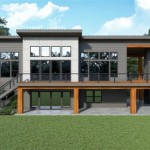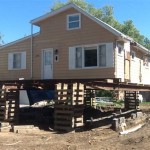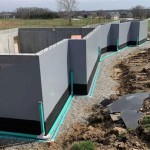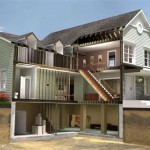Cost To Add Bedroom And Bathroom to Basement House Plans
Adding a bedroom and bathroom to a basement is a popular home renovation project that can significantly increase living space and property value. However, the cost of such an undertaking can vary greatly depending on several factors. Understanding these factors is crucial for accurate budgeting and planning.
One of the primary factors influencing cost is the existing condition of the basement. If the basement is unfinished, the project will naturally be more expensive than converting an already finished space. An unfinished basement will require framing, insulation, drywall, electrical wiring, plumbing, and HVAC installation, adding considerably to the overall expense. A finished basement, on the other hand, might only require minor modifications and the addition of plumbing fixtures and partitioning for the new bedroom and bathroom.
The size of the bedroom and bathroom is another significant cost determinant. Larger rooms require more materials and labor, directly impacting the final price. A luxurious bathroom with high-end fixtures and finishes will also be significantly more expensive than a basic, functional bathroom. Similarly, a larger bedroom requiring more extensive electrical work and HVAC adjustments will increase costs.
Geographic location plays a significant role in renovation costs. Labor rates can vary significantly from region to region, influencing the overall project expense. Material costs can also fluctuate based on local availability and transportation expenses. Building permits and inspection fees also vary by location and contribute to the final cost.
The complexity of the project is another critical factor. Adding a bathroom often entails significant plumbing work, which can be complex and expensive, particularly if the existing plumbing system requires extensive modifications. If the basement's concrete floor needs to be broken to install new drainage lines, this adds to the labor and cost. Similarly, running new electrical lines and HVAC ductwork can add complexity and expense.
The choice of materials significantly impacts the final budget. Opting for high-end finishes like marble countertops, custom cabinetry, and premium flooring will significantly increase the overall cost. Conversely, choosing more budget-friendly materials can help keep expenses down. It’s essential to carefully balance desired aesthetics with budgetary constraints.
Labor costs represent a substantial portion of the overall renovation budget. Hiring licensed and insured contractors is crucial for ensuring quality workmanship and adherence to building codes. However, experienced contractors typically command higher rates. Obtaining multiple bids from different contractors is recommended to compare prices and ensure competitive pricing.
Beyond the direct costs of construction, homeowners should also factor in additional expenses. These might include design fees if professional design services are utilized, permit fees, inspection fees, and potential costs associated with unexpected issues discovered during the renovation process. Setting aside a contingency fund for unforeseen expenses is a wise practice.
Egress windows are a crucial safety feature for basement bedrooms and are often required by building codes. These windows provide a means of escape in case of emergencies. Installing egress windows can add to the overall project cost, particularly if they require cutting through concrete foundations and installing window wells.
Basement waterproofing is another essential consideration, especially in areas prone to moisture issues. Proper waterproofing prevents water damage and mold growth, protecting the investment in the renovation. Waterproofing measures can include exterior drainage systems, interior sealants, and sump pump installation, all contributing to the project cost.
Ceiling height is an important factor both for comfort and building code compliance. Building codes typically mandate a minimum ceiling height for habitable spaces. If the existing basement ceiling height is insufficient, raising the basement ceiling can be a costly but necessary undertaking.
HVAC considerations are essential for maintaining comfortable temperatures in the new basement bedroom and bathroom. Extending existing HVAC ductwork to the new spaces or installing a separate HVAC system will add to the project cost. Ensuring proper ventilation is also crucial for preventing moisture buildup and maintaining healthy air quality.
Electrical upgrades are often necessary to accommodate the added electrical demands of a new bedroom and bathroom. This might involve installing new circuits, outlets, and lighting fixtures, adding to the overall expense. Ensuring adequate electrical capacity is crucial for safety and functionality.
Plumbing considerations include the installation of new water supply lines, drain lines, and venting for the bathroom. Connecting to the existing plumbing system can be complex and costly, especially if significant modifications are required. Choosing water-efficient fixtures can help reduce long-term water usage and utility costs.
Insulation is crucial for maintaining comfortable temperatures and reducing energy costs. Properly insulating the basement walls and ceiling helps prevent heat loss in the winter and heat gain in the summer. Choosing the right type of insulation and ensuring proper installation is vital for maximizing energy efficiency.

Versatile Spacious House Plans With Basements Houseplans Blog Com

Top 15 House Plans Plus Their Costs And Pros Cons Of Each Design

Stylish And Smart 2 Story House Plans With Basements Houseplans Blog Com

Top 15 House Plans Plus Their Costs And Pros Cons Of Each Design

Walkout Basement Contemporary Style House Plan 6630 The Sunset

Basement Floor Plans

House Plans Floor W In Law Suite And Basement Apartement

How To Create A Great Living Space For Finished Basement Layout

How Much Does A Bedroom Addition Cost 2025 Data Angi

Willow House Plan 745 Sq Ft 1 Bed Bath Garage
Related Posts







